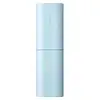What's inside
What's inside
 Key Ingredients
Key Ingredients

 Benefits
Benefits

 Concerns
Concerns

 Ingredients Side-by-side
Ingredients Side-by-side

Water
Skin ConditioningDipropylene Glycol
HumectantNiacinamide
Smoothing1,2-Hexanediol
Skin ConditioningGlycerin
HumectantMethyl Gluceth-20
HumectantHydrolyzed Hyaluronic Acid
HumectantAcrylates/C10-30 Alkyl Acrylate Crosspolymer
Emulsion StabilisingArginine
MaskingAllantoin
Skin ConditioningPanthenol
Skin ConditioningSodium Hyaluronate
HumectantAdenosine
Skin ConditioningPentylene Glycol
Skin ConditioningPolyglyceryl-10 Laurate
Skin ConditioningXanthan Gum
EmulsifyingMelia Azadirachta Leaf Extract
Skin ConditioningMelia Azadirachta Flower Extract
Skin ConditioningAnthemis Nobilis Flower Extract
MaskingTanacetum Annuum Flower Oil
MaskingAzulene
Skin ConditioningMadecassoside
AntioxidantSodium Hyaluronate Crosspolymer
HumectantCoccinia Indica Fruit Extract
Skin ConditioningXylitol
HumectantErythritol
HumectantCitrus Aurantium Bergamia Fruit Oil
MaskingHyaluronic Acid
HumectantSolanum Melongena Fruit Extract
Skin ConditioningAloe Barbadensis Flower Extract
EmollientSodium Acetylated Hyaluronate
HumectantHydroxypropyltrimonium Hyaluronate
Thymus Mastichina Flower Oil
Skin ConditioningMyristoyl/Palmitoyl Oxostearamide/Arachamide Mea
Skin ConditioningLinoleic Acid
CleansingPhytosterols
Skin ConditioningCentella Asiatica Extract
CleansingOcimum Sanctum Leaf Extract
Skin ConditioningLitsea Cubeba Fruit Oil
MaskingCurcuma Longa Root Extract
MaskingCorallina Officinalis Extract
Skin ConditioningHydrolyzed Sodium Hyaluronate
Skin ConditioningHydroxyacetophenone
AntioxidantWater, Dipropylene Glycol, Niacinamide, 1,2-Hexanediol, Glycerin, Methyl Gluceth-20, Hydrolyzed Hyaluronic Acid, Acrylates/C10-30 Alkyl Acrylate Crosspolymer, Arginine, Allantoin, Panthenol, Sodium Hyaluronate, Adenosine, Pentylene Glycol, Polyglyceryl-10 Laurate, Xanthan Gum, Melia Azadirachta Leaf Extract, Melia Azadirachta Flower Extract, Anthemis Nobilis Flower Extract, Tanacetum Annuum Flower Oil, Azulene, Madecassoside, Sodium Hyaluronate Crosspolymer, Coccinia Indica Fruit Extract, Xylitol, Erythritol, Citrus Aurantium Bergamia Fruit Oil, Hyaluronic Acid, Solanum Melongena Fruit Extract, Aloe Barbadensis Flower Extract, Sodium Acetylated Hyaluronate, Hydroxypropyltrimonium Hyaluronate, Thymus Mastichina Flower Oil, Myristoyl/Palmitoyl Oxostearamide/Arachamide Mea, Linoleic Acid, Phytosterols, Centella Asiatica Extract, Ocimum Sanctum Leaf Extract, Litsea Cubeba Fruit Oil, Curcuma Longa Root Extract, Corallina Officinalis Extract, Hydrolyzed Sodium Hyaluronate, Hydroxyacetophenone
Water
Skin ConditioningButylene Glycol
HumectantDipropylene Glycol
HumectantGlycerin
HumectantSqualane
Emollient1,2-Hexanediol
Skin ConditioningAmmonium Acryloyldimethyltaurate/Vp Copolymer
Propanediol
SolventCarbomer
Emulsion StabilisingCetearyl Alcohol
EmollientTromethamine
BufferingPolyglyceryl-3 Methylglucose Distearate
EmulsifyingDextrin
AbsorbentHydrogenated Lecithin
EmulsifyingEthylhexylglycerin
Skin ConditioningParfum
MaskingGlyceryl Stearate Citrate
EmollientDisodium EDTA
Betaine
HumectantHydrolyzed Hyaluronic Acid
HumectantBeta-Glucan
Skin ConditioningXylitylglucoside
HumectantAnhydroxylitol
HumectantXylitol
HumectantLactobacillus Ferment Lysate
Skin ConditioningGlucose
HumectantTocopherol
AntioxidantMagnesium Chloride
Tetradecyl Aminobutyroylvalylaminobutyric Urea Trifluoroacetate
Skin ConditioningUndaria Pinnatifida Extract
Skin ConditioningWater, Butylene Glycol, Dipropylene Glycol, Glycerin, Squalane, 1,2-Hexanediol, Ammonium Acryloyldimethyltaurate/Vp Copolymer, Propanediol, Carbomer, Cetearyl Alcohol, Tromethamine, Polyglyceryl-3 Methylglucose Distearate, Dextrin, Hydrogenated Lecithin, Ethylhexylglycerin, Parfum, Glyceryl Stearate Citrate, Disodium EDTA, Betaine, Hydrolyzed Hyaluronic Acid, Beta-Glucan, Xylitylglucoside, Anhydroxylitol, Xylitol, Lactobacillus Ferment Lysate, Glucose, Tocopherol, Magnesium Chloride, Tetradecyl Aminobutyroylvalylaminobutyric Urea Trifluoroacetate, Undaria Pinnatifida Extract
 Reviews
Reviews

Ingredients Explained
These ingredients are found in both products.
Ingredients higher up in an ingredient list are typically present in a larger amount.
1,2-Hexanediol is a synthetic liquid and another multi-functional powerhouse.
It is a:
- Humectant, drawing moisture into the skin
- Emollient, helping to soften skin
- Solvent, dispersing and stabilizing formulas
- Preservative booster, enhancing the antimicrobial activity of other preservatives
Dipropylene Glycol is a synthetically created humectant, stabilizer, and solvent.
This ingredient helps:
Dipropylene glycol is technically an alcohol, but it belongs to the glycol family (often considered part of the ‘good’ alcohols). This means it is hydrating and gentle on skin unlike drying solvent alcohols like denatured alcohol.
As a masking agent, Dipropylene Glycol can be used to cover the smell of other ingredients. However, it does not have a scent.
Studies show Dipropylene Glycol is considered safe to use in skincare.
Learn more about Dipropylene GlycolGlycerin is already naturally found in your skin. It helps moisturize and protect your skin.
A study from 2016 found glycerin to be more effective as a humectant than AHAs and hyaluronic acid.
As a humectant, it helps the skin stay hydrated by pulling moisture to your skin. The low molecular weight of glycerin allows it to pull moisture into the deeper layers of your skin.
Hydrated skin improves your skin barrier; Your skin barrier helps protect against irritants and bacteria.
Glycerin has also been found to have antimicrobial and antiviral properties. Due to these properties, glycerin is often used in wound and burn treatments.
In cosmetics, glycerin is usually derived from plants such as soybean or palm. However, it can also be sourced from animals, such as tallow or animal fat.
This ingredient is organic, colorless, odorless, and non-toxic.
Glycerin is the name for this ingredient in American English. British English uses Glycerol/Glycerine.
Learn more about GlycerinHydrolyzed Hyaluronic Acid is a form of hyaluronic acid. It is created by the hydrolysis of hyaluronic acid with a high molecular weight. Once created, Hydrolyzed Hyaluronic Acid has a low molecular weight.
Low molecular weight HA has been shown to hydrate and increase elasticity of the skin. Increasing elasticity is also associated with reduction of wrinkle depth.
One study found topical low molecular weight hyaluronic acid may be considered for the treatment of rosacea in the adult population. However, we always recommend speaking with a professional about your skin concerns.
Hyaluronic acids are a humectant. This means they draw moisture from the air. Hyaluronic acids help moisturize, soothe, and protect the skin.
Read more about other common forms of hyaluronic acid:
Learn more about Hydrolyzed Hyaluronic AcidWater. It's the most common cosmetic ingredient of all. You'll usually see it at the top of ingredient lists, meaning that it makes up the largest part of the product.
So why is it so popular? Water most often acts as a solvent - this means that it helps dissolve other ingredients into the formulation.
You'll also recognize water as that liquid we all need to stay alive. If you see this, drink a glass of water. Stay hydrated!
Learn more about WaterXylitol is a humectant and prebiotic. It can help with dry skin.
In studies, xylitol has been shown to improve dry skin. It decreased transepidermal water loss, or when water passes through the skin and evaporates. Xylitol also showed to help improve the biomechanical properties of the skin barrier.
The prebiotic property of xylitol may also help reinforce our skin's natural microbiome. Having a healthy microbiome prevents infection by bad bacteria and helps with hydration.
As a humectant, Xylitol helps draw moisture from both the air and from deeper skin layers. This helps keep skin hydrated.
Xylitol is a sugar alcohol and commonly used as a sugar substitute. It is naturally occurring in plants such as strawberries and pumpkin.
Learn more about Xylitol